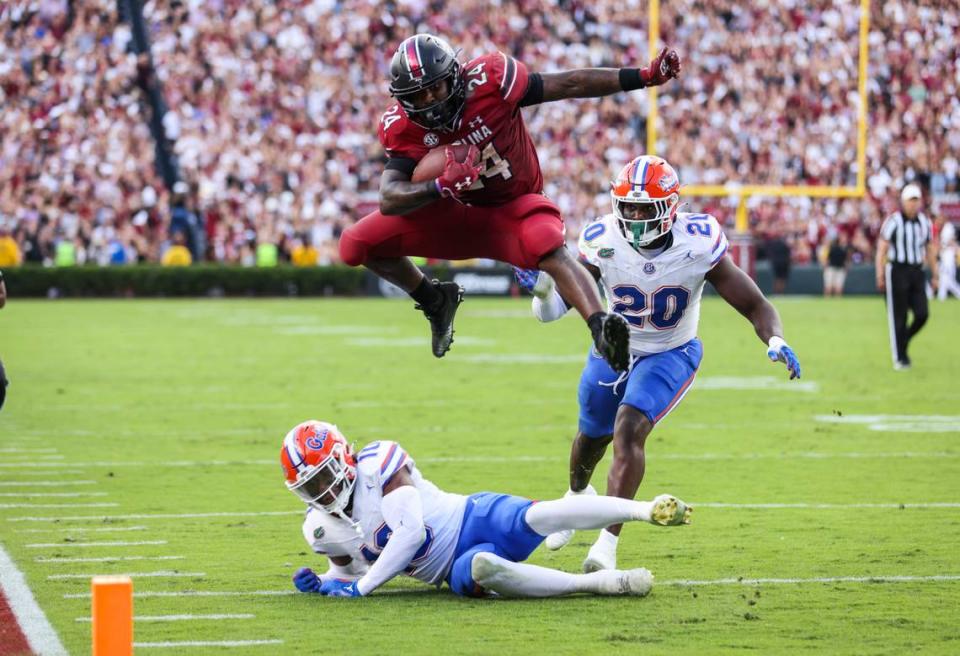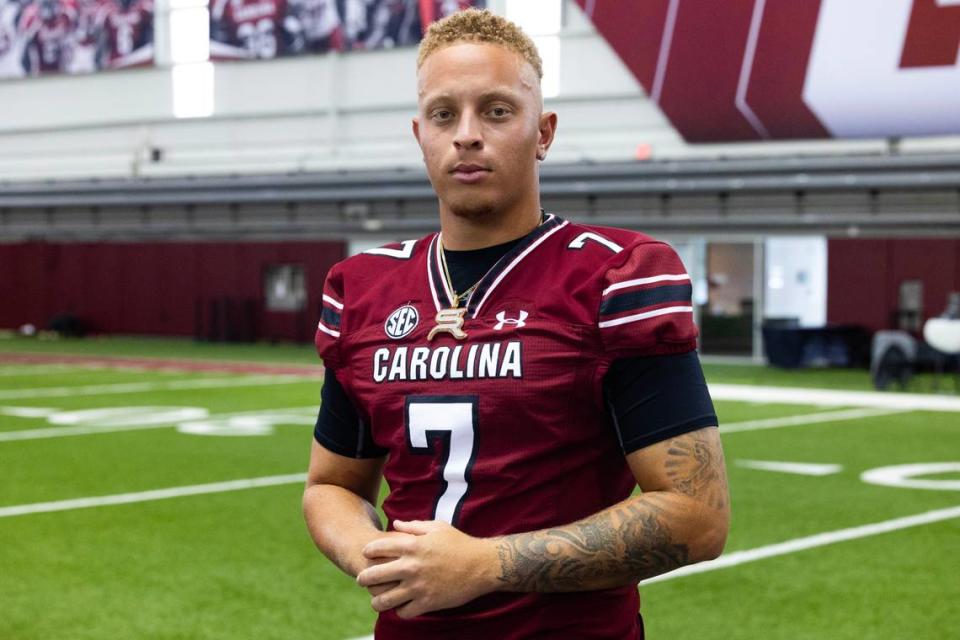Exclusive: NIL leaders talk USC priority shift, coach input, deciding a player’s value
- Oops!Something went wrong.Please try again later.
- Oops!Something went wrong.Please try again later.
- Oops!Something went wrong.Please try again later.
A year ago, the Garnet Trust NIL collective had one goal that trumped everything else: Keep Spencer Rattler in Columbia. Or, rather, present an NIL package alluring enough for Rattler to remain a Gamecock rather than enter the NFL Draft.
“This year, for the vast majority of our conversations,” said Mark Bonnoitt, the director of development for Garnet Trust, “we made it a priority that we wanted to keep guys at South Carolina. We prioritized guys on the roster and that’s why you’ve seen on Twitter (the posts) that these guys have signed with the Garnet Trust.”
The process of getting to that point, though, is part of the mystery. What goes into Player X signing an agreement with the Garnet Trust, which became the official name, image and likeness partner of South Carolina athletics back in July.
Because the amount of money and resources at the disposal of a school’s collective can impact who leaves, who stays and who joins the football program — whether as a high school recruit or a transfer — one can make a convincing argument that the strength of an NIL collective can correlate to success on the field.
Collectives are not the foundation of a college football team, but they sort of act as the roof — the umbrella that allows everything else to function normally. Say a storm (the transfer portal) hits. A sturdy house is still going to flood.
Despite its importance, however, the inner-workings of a collective are largely a mystery.
The Garnet Trust was willing to peel back the curtain and provide The State with transparency about how a collective impacts roster retention in college football.
Jeremy Smith, the operations director for Garnet Trust, noted the collective initiated the conversations on “90% of the deals we made.” The student-athlete then meets with Smith and Bonnoitt inside a conference room at USC’s Rice Athletics Center, where the negotiations began.
If this were a cookie-cutter process — say, like the NFL — this would probably be a whole lot easier. But these are college kids, sometimes 19 years old, making their first monetary negotiation outside of perhaps a Facebook Marketplace pickup. Every guy, every situation is different.
Some, like Rattler (who is represented by agent Chris Cabott, whose client list also includes Kansas City Chiefs quarterback Patrick Mahomes) walks into the room with high-level representation. Other guys bring with them an NIL agent or have an agent on the phone to speak with the Garnet Trust folks. Others might bring in their parents or an uncle who might have a very limited understanding of the NIL marketplace.
Most of the time, Smith and Bonnoitt have an idea of what kind of money the player is looking for.
“A lot of times they’ll go to their position coach and say, ‘Hey, I want to stay but I wanna make this,’ ” Smith said. “I will say luckily here at South Carolina, it’s not like a lot of other schools (that) we hear of where players are threatening to leave if they don’t get a certain amount of money.”
It’s easy to think that NIL money is the deciding factor for a majority of the kids who choose to enter the transfer portal. And, for some, it is. But since the 2023 season ended Nov. 25, 21 South Carolina football players have entered the transfer portal. Garnet Trust’s leaders are adamant that very few of them based their decision to leave on money.
According to Smith, star wide receiver Antwane “Juice” Wells — who committed to Ole Miss — did not leave because of NIL money. Conversely, Smith said, NIL money did play a role in running back Mario Anderson entering the transfer portal. (He has since committed to Memphis.)
“Mario Anderson received a very-competitive offer,” Bonnoitt said. “Like very good.”
And he turned it down?
“Yeah,” Bonnoitt added.
The State has reached out to Anderson seeking comment related to NIL and his dealings with Garnet Trust.

The new route for roster retention
The new college football is a cloak-and-dagger operation.
There is a higher degree of secrecy and ambiguity to how this sport operates. There are rules for the transfer portal and NIL, but they are so vague that agents, athletes and schools have largely ignored them without punishment.
Think about this: A few weeks back, Colorado State head coach Jay Norvell became the latest coach to call out tampering, admitting that “our top 12 players on our team have all had offers to go other places.”
“The NIL is real,” Norvell added. “We’re fighting to improve our situation with NIL, and if we don’t get improvement, we’re going to lose a lot of kids. It’s just the bottom line.”
He’s right. And, though it’s on a larger scale, it is the same problem facing South Carolina and many other Power-5 programs. If a school does not have the adequate NIL resources, it will be eaten alive.
Which brings us to a restaurant just after 4:30 p.m. on a recent Monday, when Smith’s phone buzzes for the billionth time that day. He apologizes, gets up and walks outside to talk the call.
Smith is the operating director of the Garnet Trust NIL collective. And, for those unfamiliar, a collective works separately from the university but can fund name, image and likeness opportunities for student-athletes by pooling money together from fans and boosters.
The collective can then sign a contract with a player that will allow it to compensate the athlete in exchange for such things as signing autographs, sharing promotional social media posts or making appearances at fundraisers or charitable events.
The reality: It is a loophole for paying players. And it’s becoming one of the most important tools to acquiring, and retaining, talent in college athletics.
Recently, the Garnet Trust began releasing social media graphics to indicate it has signed a South Carolina football player to a deal. It’s the new lingo for “retention.” Rather than a player announcing he’s going to stay at South Carolina and not enter the transfer portal, he can say he has signed with the Garnet Trust.
Over the past few weeks, Garnet Trust signed deals with: QB LaNorris Sellers, DT Tonka Hemingway, DT Alex “Boogie” Huntley, DT T.J. Sanders, DB O’Donnell Fortune, DB Jalon Kilgore, LB Bam Martin-Scott, LB Debo Williams, TE Joshua Simon, WR Luke Doty and OL Tree Babalade. At least two of those players — Hemingway and Fortune — were rumored to be considering a move to other SEC programs.
In other words, those players have individually negotiated a financial deal with the Garnet Trust to stay at South Carolina and not enter the transfer portal.
— TheGarnetTRUST (@TheGarnetTrust) December 5, 2023
So, how much is a player worth?
Asked how often he talks to USC’s coaching staff, Smith looked down at his phone.
“Well,” he said. “I’m talking to one right now.”
Every program at South Carolina chooses to handle roster management — or NIL discussions — differently.
“Dawn Staley wants to deal with it first-hand,” Smith says “Lamont Paris passes it to (assistant coach) Carey Rich. Shane (Beamer) pushes it to (director of player personnel) Taylor Edwards, but I was just texting with Shane. We stay in very close communication. I would say (what we do) the least is talk to position coaches or coordinators on a daily basis, because you need to have one (contact within each coaching staff), if you will.”
And, Smith was asked, are the coaches able to give you the directive of, “Hey, we really value this guy or, hey, here’s what we’re willing to spend on that guy?”
“Well, we own the budget so they don’t tell us what to spend on them,” he said. “But, yes, they do tell us who the priorities are. For sure. I mean, we always ask before we go into a deal to make sure they’re in good standing with the team. The last thing we want to do is promote a player and pay them money just to find out they skipped school twice.”
The next question is simple: How does the collective know how much to pay a player? This is where things get tricky.
The NIL market is a guessing game. Because deals don’t have to be made public, figures can be thrown around willy-nilly. Perhaps teammates or just players across college football speak of what they’ve been offer or accepted, but sometimes even those guarantees don’t come to fruition. And with little precedent, the market is constantly changing.
No one actually knows how much the hot transfer-portal wide receiver made or, more specifically, how much Georgia quarterback Carson Beck makes from the Georgia collective or his other NIL deals. The recruiting website On3 put a $1.1 million NIL valuation on Beck, but that number is probably off the mark.
A few months ago, Nebraska head coach Matt Rhule said publicly that “a good quarterback in the portal costs $1 million to $1.5 million to $2 million right now.” But, again, there are no official numbers, which means it’s extremely hard to understand the market.
In the NFL, teams can negotiate with quarterbacks knowing what other quarterbacks make. They can determine at least a ballpark for a fair-market value. NIL collectives don’t have that luxury.
This is where creativity becomes necessary.
“So we have kind of worked off the idea that we know what our budget is for 2024,” said Bonnoitt, who graduated from USC in 2019 and has been involved in state political campaigns since high school. “And we have used some NFL-esque math.”
Bonnoitt knows that sounds a little wonky, so he offers an example: Say a starting tight end over the last 10 years in the NFL, he gives as a hypothetical, has accounted for 6% of their team’s salary cap, Garnet Trust can have a baseline of 6% for what it will pay South Carolina’s starting tight end.
That figure is not cut and dry. There’s a range. Let’s say the number is $100,000, he offers as another example, Garnet Trust might then offer that tight end $75,000 and “that gives us a little negotiating room,” he says, “and then we agree to a number.”
That value and that range, though, is also dictated by what South Carolina needs on its football team. If the Gamecocks desperately need their offensive line to stay intact, perhaps the USC offensive linemen are worth more. Or maybe Rattler was only worth X, but South Carolina really valued him and Garnet Trust needed to pay him more than X.

The evolution of NIL at South Carolina
As Smith and Bonnoitt talk, it becomes clear that, like so many college coaches and administrators, they too have had to learn and understand the NIL dynamic in a hurry.
Eighteen months ago, Smith was living in Florida, running a small executive recruiting company that he had operated for a dozen years. Five years ago, Bonnoitt was a student at South Carolina, packing into Williams-Brice Stadium to cheer on the Gamecocks. He left college and got involved in politics, working as a campaign manager for Jay Jordan’s state Senate run and joined Garnet Trust back in February.
“(Once) Mark came aboard and we knew we were going to have a fundraising piece to this, we knew it was going to hit a little bit more,” Smith said.
It’s wild to think about. Not very long ago, they were South Carolina fans. And now they are talking to the head football coach almost daily, trying to boost forward the program they loved so much.
While it might sound odd, here’s the reality: No one had a job in this realm before July 2021, when the NCAA first accepted an NIL policy. No one went to school to run a collective. No one was thinking five years ago about managing a college salary cap.
So, when it became South Carolina’s official collective in July, Garnet Trust had to work quick. Educating folks. Fundraising. Appealing to the big fish used to giving money straight to USC. Inviting in the casual fan willing to chip in $10 a month. If nothing else, the growth has been exceptional.
“Our budget was 15 times larger in 2023 than it was in 2022,” Bonnoitt said, later adding that Garnet Trust has tripled its membership (now around 2,000) in the past six months.
They declined to disclose an official revenue number because in the competitive world of NIL, any dollar figure thrown out can be used against you in recruiting battles. But when asked what their goals are for the next year, Bonnoitt said, “We feel like we need to raise somewhere between $6 million and $8 million school-wide on an annual basis.”
The Garnet Trust got a nice boost to that in December. During a recent fundraising campaign, an anonymous donor pledged to match whatever the collective could raise up to $1 million. In less than three weeks, the Garnet Trust collected $1,192,003.
“I’d say in the last 45 days,” Smith said a few weeks back, “we’ve seen more support and production than we’ve seen in the last year and a half.”
Back in August, The State asked Smith where South Carolina stacked up in the NIL space.
“I would say we’re in the bottom quarter overall of the SEC specifically and also our in-state rival,” he said. “We are definitely a little bit behind.”
Fast forward four months and Bonnoitt said this: “Absolutely, South Carolina is competitive in the NIL space. Does that mean I think we’re the number-one offer for every kid out of the transfer portal? No. … If we find a guy who we feel like can fit our scheme, can we offer an NIL package competitive to (where) other schools are? Yes.”

Using a few formulas for NIL
During this offseason, likely sometime in the summer once the season and transfer portal windows have closed, Smith and Bonnoitt want to network. This space resembles professional sports more and more every day. So while it might help to speak with others in the NIL world, it might be even more beneficial to converse with those who deal with salary-cap numbers daily.
“I’m going to try and get us with the (Atlanta) Braves and talk to them from a budget (standpoint),” Smith said, “and probably talk to a couple NFL general managers.”
NIL started as an innocent endeavor. Local pizza shop pays quarterback for social media post — things like that. In less than three years, it has evolved into professional sports, where the folks heading collectives need to become diligent fundraisers, negotiators and salary-cap masters.
Which is how the book (and movie) “Moneyball” gets brought up.
“We have a couple of interns and they’re like Jonah Hill in ‘Moneyball,’ ” Smith said. “They’re like stat geeks.”
He explained how Garnet Trust’s interns use the website Pro Football Focus. The site, which also has a college-football-centric branch, has evaluators grade every player in football on every play, give them a grade and put them in a percentile against others who play the same position.
The Garnet Trust interns track every South Carolina player’s PFF grade and then compares it to others in the SEC and Power 5.
Former USC wide receiver “Xavier Legette, he was in the 93rd percentile. It makes sense,” Smith said, offering up a hypothetical. “So, Joe the left guard comes and says, ‘I want a million dollars,’ and you look at the PFF (grades) and he’s in the 12th percentile and there’s 88% of people better. I’m sure we can find someone better for less than a million dollars.”
Smith continues: “It goes back to ‘Moneyball’: Could we find the same production at a lower cost.’ Not that we have — we’ve not used that, but the data is there in case we need to. … If we can say, this kid wants some absurd money — or perceived absurd money — who else is playing in the same space as him if we’re looking for the same level (of) production? If they’re in the portal, why not at least have the conversation? That person could literally be at a much-smaller school and the idea of jumping to a conference like the SEC, that might be enough NIL for him, so to speak.”
These are the conversations that have always been taboo in college football. Paying players was illegal. Paying for a meal or autographs — or just flat out paying them — could push a school so far down in the NCAA sanctions dungeon that it takes decades to climb back out. SMU, which is joining the ACC this year, received the “death penalty” from the NCAA in 1987 for repeatedly paying its players.
Today, the only taboo is not acknowledging it. Not embracing it.
But once it is embraced, the arms race begins.

